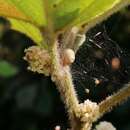en
names in breadcrumbs


Bertrana is a genus of Central and South American orb-weaver spiders first described by Eugen von Keyserling in 1884.[3] It includes some of the smallest known araneid orb-weavers.[4][5] Bertrana striolata females are 4.5 mm long or less.[4][5] The eight eyes are in two rows. The abdomen is white on top and on the sides, with multiple hieroglyphic-like lines and bars of many different shapes and length. In females, these are red, in males, black.[6]
As of April 2019 it contains twelve species:[1]
Bertrana is a genus of Central and South American orb-weaver spiders first described by Eugen von Keyserling in 1884. It includes some of the smallest known araneid orb-weavers. Bertrana striolata females are 4.5 mm long or less. The eight eyes are in two rows. The abdomen is white on top and on the sides, with multiple hieroglyphic-like lines and bars of many different shapes and length. In females, these are red, in males, black.